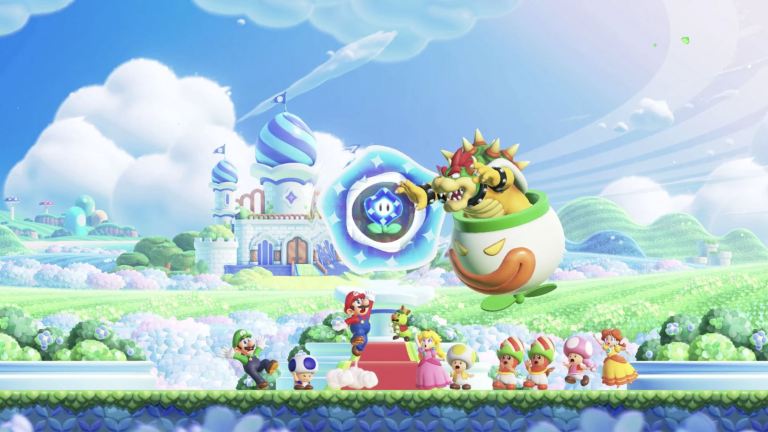Why Takashi Tezuka Is the Unsung Hero of the Super Mario Franchise
He may not be a household name, but Takashi Tezuka's contributions to the Super Mario franchise deserve a lot of love.

This month sees the launch of Super Mario Bros. Wonder: the first new Super Mario game on the Nintendo Switch since 2017’s Super Mario Odyssey and the first side-scrolling Super Mario game since 2012’s New Super Mario Bros. U on the Wii U.
While there’s plenty of buzz about Wonder being the first Super Mario game to feature a different voice actor for Mario (instead of franchise veteran Charles Martinet) in over 25 years, the game also marks the return of prolific Nintendo developer Takashi Tezuka, who serves as Super Mario Bros. Wonder’s producer.
A presence with the Super Mario series since the beginning, Tezuka is the unsung figure behind making the video game hero a global icon and figurehead of the entire video game industry.
Takashi Tezuka’s Extensive History at Nintendo
Tezuka joined Super Mario creator Shigeru Miyamoto as the assistant director and co-designer of 1985’s Super Mario Bros.: the first official game in the Super Mario series after the character previously appeared in the successful arcade titles Donkey Kong and Mario Bros. Early in development, it was Tezuka who suggested making the protagonist of the Nintendo Entertainment System’s launch title Mario, citing the recent success of Mario Bros. in the arcade market. Similarly, while Miyamoto initially envisioned the game’s primary antagonist, Bowser, as an anthropomorphic ox, Tezuka recommended the character be changed into a turtle and redesigned the villain’s final appearance with Miyamoto.
Tezuka played an even more pivotal role in Nintendo the following year, directing and designing both The Legend of Zelda and the original Japanese version of Super Mario Bros. 2 with Miyamoto in 1986. Though unreleased in the North American market for years, Super Mario Bros. 2 marked Tezuka’s directorial debut and refined the side-scrolling gameplay from its predecessor. Tezuka closed out his work on the NES era by co-directing and co-designing 1988’s Super Mario Bros. 3, extensively adding to the franchise’s power-ups, enemies, and usage of secret paths and level endings.
For 1990’s Super Mario World, the launch title for the Super Nintendo, Tezuka was the sole director, with Miyamoto keeping his duties focused on serving as the game’s producer. At the request of Miyamoto, who wanted Mario to ride a dinosaur companion ever since the development of Super Mario Bros. 3 began, Tezuka created Yoshi with designer Shigefume Hino to accommodate this desire for Super Mario World. Enormously popular, Yoshi received his own spinoff line of video game titles starting with 1995’s Super Mario World 2: Yoshi’s Island, co-directed by Tezuka and Hino.
For much of the early ‘90s, Tezuka was focused on shepherding the Legend of Zelda series onto the Super Nintendo and Game Boy with 1991’s The Legend of Zelda: A Link to the Past and 1993’s The Legend of Zelda: Link’s Awakening, respectively. However, Tezuka also was instrumental in keeping Mario’s classic legacy alive, directing 1993’s Super Mario All-Stars. More than just compiling the Super Mario games from the NES era into a single SNES title, including the North American debut of the original Super Mario Bros. 2, the compilation took advantage of the Super Nintendo’s hardware advances to update the technical specifications on the collected games.
For much of the Nintendo 64 era, Tezuka settled into a more supervisory role, making sure Nintendo’s properties maintained the ethos that made them so successful (even as the properties themselves branched into different genres). Tezuka is a credited supervisor on 1999’s Mario Golf, 2000’s Mario Tennis and Paper Mario, along with both Legend of Zelda titles for the N64. Tezuka also helped usher Mario into 3D as an assistant director on 1996’s Super Mario 64, with the game’s usage of Boos actually being inspired by Tezuka’s wife.
By 1997, Tezuka progressed to the role of producer, starting with that year’s Yoshi’s Story, as Yoshi received his largest solo spinoff title at that time. Tezuka maintained this role into the subsequent GameCube era, producing 2001’s Luigi’s Mansion, along with 2002’s Super Mario Sunshine and Mario Kart: Double Dash. During this period, Tezuka’s working relationship with Miyamoto continued to grow, with the two visionary game developers launching the Pikmin franchise. However, Tezuka’s biggest accomplishment during the GameCube era was producing 2001’s Animal Crossing. A reunion between Tezuka and much of Yoshi’s Story development team, that slice-of-life game would spawn one of Nintendo’s most successful franchises.
While certainly a prominent force behind the GameCube, it was Tezuka’s subsequent work on the Nintendo DS that would reinvigorate his influence on the Super Mario series, including how its gameplay would inform the eventual development of Super Mario Bros. Wonder.
Back-to-the-Basics Approach
The 2006 Nintendo DS title New Super Mario Bros. was the first side-scrolling platformer starring Mario in nearly 15 years, modernizing the gameplay with tightly crafted levels and new power-ups while taking advantage of the DS’ dual-screen functionality. Tezuka held a general producer role on the game but would play a much more active role in the series moving forward. Serving as producer, Tezuka brought the renewed 2D approach to the Wii with 2009’s New Super Mario Bros. Wii, which boasted four-player simultaneous gameplay, with the game becoming the fourth-bestselling game for the Wii overall.
2012 quickly became a pivotal year for Tezuka, who produced both New Super Mario Bros. 2 for the Nintendo 3DS and New Super Mario Bros. U as a launch title for the Wii U. While the former became a strong seller for the 3DS, New Super Mario Bros. U did not visibly help move Wii U units during its initial launch window. This muted response even after the release of the DLC expansion New Super Luigi U less than a year later as part of Nintendo’s costly Year of Luigi initiative. While a strong seller compared to the rest of the Wii U library’s tepid response, New Super Mario Bros. U would truly find its audience on the Nintendo Switch, with Tezuka producing an enhanced port in 2019 rebranded as New Super Mario Bros. U Deluxe.
Beyond side-scrolling titles, Tezuka also produced 2010’s Super Mario Galaxy 2 for the Wii and held a general producer position on 2013’s Super Mario 3D World for the Wii U, another four-player Super Mario platformer taking New Super Mario Bros. U’s gameplay sensibilities into 3D. Both of these games feature hallmarks of Tezuka’s game development sensibilities, sticking with a format that has been proven to work before while refining it for a fresh experience. Super Mario Galaxy 2 is quite similar to the original Super Mario Galaxy (just as Super Mario Bros. 2 is similar to its own predecessor) but features a deepening of gameplay and greater breadth in level design.
Super Mario 3D World takes the New Super Mario Bros. formula and its four-player gameplay, but with the added scope and depth possible by playing as a 3D platformer instead of as a side-scroller.
Through it all, Tezuka remained a constant presence in other Super Mario titles, producing all three Super Mario Maker games and supervising the Mario & Luigi handheld RPG series, based on his experience working with the Paper Mario series and overall familiarity with the franchise.
Takashi Tezuka and Super Mario Bros. Wonder
Super Mario Bros. Wonder is Tezuka’s biggest project since New Super Mario Bros. U and the biggest title he’s been listed as the sole producer on during his entire tenure with the Super Mario franchise. With a development window lasting since the completion of New Super Mario Bros. U Deluxe in 2019, Tezuka and the rest of the team have enjoyed a lengthy window to let their ideas come to fruition. Nintendo has kept many details about Wonder tightly under wraps, but Tezuka has hinted at gameplay elements that change the appearance of levels rather than necessarily changing Mario himself.
Like Miyamoto and composer and sound designer Koji Kondo, Tezuka has been a part of the Super Mario franchise ever since the plumber first charmed Famicom players in 1985. And though Miyamoto tends to overshadow Tezuka’s recognition with gamers, Tezuka has been a major creative force in Mario’s success for nearly 40 years. That statement certainly isn’t meant to disparage Miyamoto (who has created many of Nintendo’s greatest franchises since his tenure with the company began in 1977) but is instead an effort to shine a bigger spotlight on Tezuka who has effectively worked with Miyamoto for decades in bringing their shared visions to life.
If there was a Mount Rushmore of figures that made Nintendo into the gaming industry powerhouse that it is today, Tezuka absolutely deserves a spot on it, specifically for his contributions to Super Mario and The Legend of Zelda. Tezuka’s gaming ethos has been to allow hardware capabilities and technical advances to enhance gameplay experiences, not restrictively define them. With Super Mario Bros. Wonder and its return to side-scrolling gameplay, with a surprising amount of depth, Tezuka is about to display his game-developing prowess in new and exciting ways on his biggest project yet. And hopefully, with Wonder’s launch, Tezuka will finally get the overdue respect and recognition he so well deserves.
Developed and published by Nintendo, Super Mario Bros. Wonder will be released on October 20 for the Nintendo Switch.
